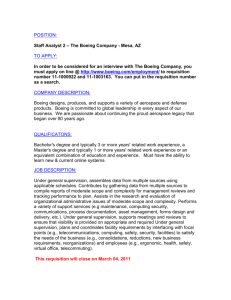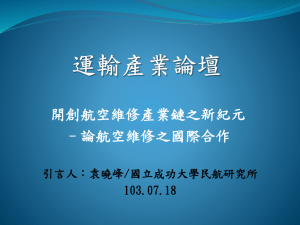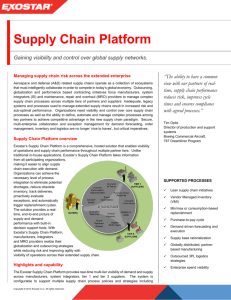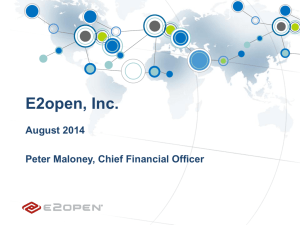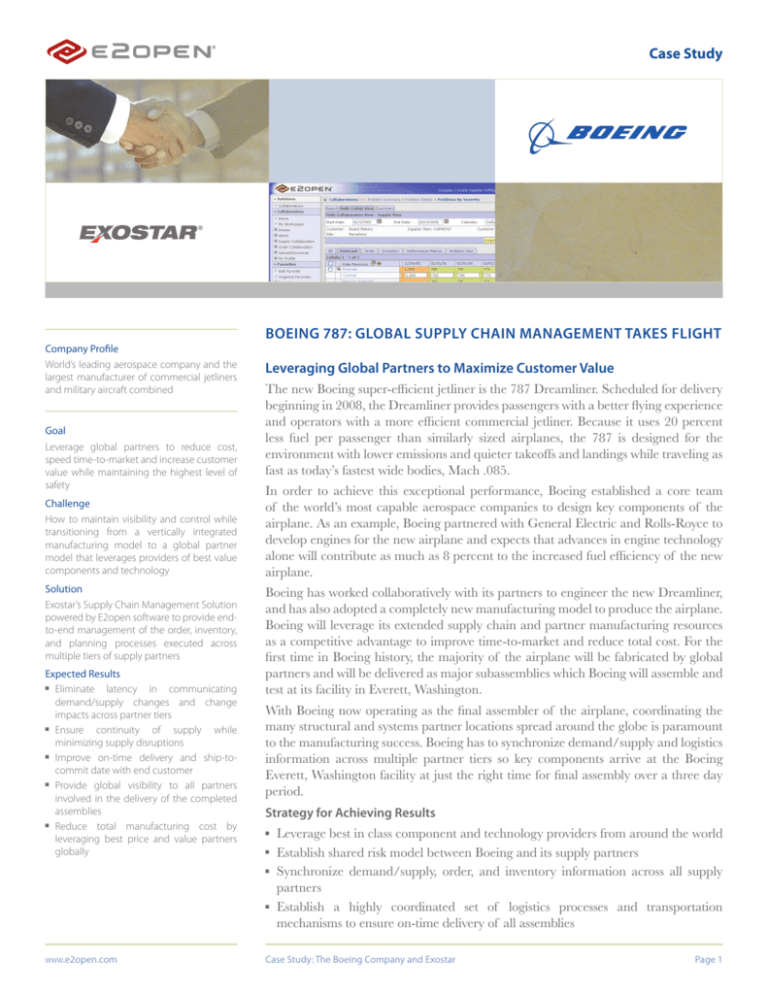
Case Study
Company Profile
World’s leading aerospace company and the
largest manufacturer of commercial jetliners
and military aircraft combined
Goal
Leverage global partners to reduce cost,
speed time-to-market and increase customer
value while maintaining the highest level of
safety
Challenge
How to maintain visibility and control while
transitioning from a vertically integrated
manufacturing model to a global partner
model that leverages providers of best value
components and technology
Solution
Exostar’s Supply Chain Management Solution
powered by E2open software to provide endto-end management of the order, inventory,
and planning processes executed across
multiple tiers of supply partners
Expected Results
■ Eliminate
latency in communicating
demand/supply changes and change
impacts across partner tiers
■ Ensure
continuity of supply while
minimizing supply disruptions
■ Improve on-time delivery and ship-tocommit date with end customer
■ Provide global visibility to all partners
involved in the delivery of the completed
assemblies
■ Reduce
total manufacturing cost by
leveraging best price and value partners
globally
BOEING 787: GLOBAL SUPPLY CHAIN MANAGEMENT TAKES FLIGHT
Leveraging Global Partners to Maximize Customer Value
The new Boeing super-efficient jetliner is the 787 Dreamliner. Scheduled for delivery
beginning in 2008, the Dreamliner provides passengers with a better flying experience
and operators with a more efficient commercial jetliner. Because it uses 20 percent
less fuel per passenger than similarly sized airplanes, the 787 is designed for the
environment with lower emissions and quieter takeoffs and landings while traveling as
fast as today’s fastest wide bodies, Mach .085.
In order to achieve this exceptional performance, Boeing established a core team
of the world’s most capable aerospace companies to design key components of the
airplane. As an example, Boeing partnered with General Electric and Rolls-Royce to
develop engines for the new airplane and expects that advances in engine technology
alone will contribute as much as 8 percent to the increased fuel efficiency of the new
airplane.
Boeing has worked collaboratively with its partners to engineer the new Dreamliner,
and has also adopted a completely new manufacturing model to produce the airplane.
Boeing will leverage its extended supply chain and partner manufacturing resources
as a competitive advantage to improve time-to-market and reduce total cost. For the
first time in Boeing history, the majority of the airplane will be fabricated by global
partners and will be delivered as major subassemblies which Boeing will assemble and
test at its facility in Everett, Washington.
With Boeing now operating as the final assembler of the airplane, coordinating the
many structural and systems partner locations spread around the globe is paramount
to the manufacturing success. Boeing has to synchronize demand/supply and logistics
information across multiple partner tiers so key components arrive at the Boeing
Everett, Washington facility at just the right time for final assembly over a three day
period.
Strategy for Achieving Results
■
■
■
■
WWW.e2open.com
Leverage best in class component and technology providers from around the world
Establish shared risk model between Boeing and its supply partners
Synchronize demand/supply, order, and inventory information across all supply
partners
Establish a highly coordinated set of logistics processes and transportation
mechanisms to ensure on-time delivery of all assemblies
Case Study: The Boeing Company and Exostar
Page 1
The Aircraft
■ Thousands and thousands of unique parts
will be used to build the airplane.
■ 50
percent of the primary structure,
including the fuselage and wing, will be
made of composite.
■ More than 100 partners across 12 countries
on 5 continents are involved in the
manufacturing and delivery process.
■ 11 major subassemblies will be delivered to
Everett, WA for final assembly.
■ First
flight is expected in 2007 with
certification, delivery and entry into service
occurring in 2008.
How the Strategy was Executed
■
■
■
■
Move to partner-led manufacturing and fabrication model for the 787 Dreamliner
Establish partner managed inventory programs with Boeing managed contracts to
share risk and improve supply availability
Implement common tools to provide global visibility to all demand/supply, order,
and inventory information across multiple tiers of partners
Invest in logistics visibility tools and specialized transport mechanisms to reliably
move large subassemblies globally
Challenges Posed by Partner Manufacturing Model
The Boeing 787 Dreamliner represents a fundamental shift in manufacturing
philosophy and approach for The Boeing Company. With 135 structural and systems
partner locations around the world involved in the manufacturing and fabrication
of the airplane, coordinating the end to end supply chain across these partners is
paramount to the program’s success.
One of the biggest challenges in this production model is ensuring that all partners
have access and visibility to the latest demand information from Boeing and that
Boeing has visibility to the supplier’s ability to meet the delivery schedule. It is crucial
that all of the major subassemblies arrive in Washington at the same time for final
assembly. If a sub assembly is late or missing, there is very little time or space for
Boeing to store the other large components. If a partner can not meet an expected
delivery date then Boeing must adjust the schedule and potentially delay the arrival
of the other assemblies.
Another critical success factor is to ensure continuity of supply of component parts
being consumed by the Tier 1, volume partners. Due to the critical nature and dollar
value of some of these component parts, Boeing retained contractual relationships
directly with the Tier 2, providing partners. One of the benefits to the Tier 2
supplier is shorter payment cycles. The challenge was implementing a pull based
replenishment model between the Tier 1 and Tier 2 partners that could be supported
by the commercial relationship and payment process between Boeing and the Tier 2
partners.
Above all else, Boeing and their partners needed a way to quickly identify potential
problems across the supply chain and immediately assess their impacts on other
partners or aspects of the manufacturing process. As an example, if a component
part replenishment shipment was late, will it cause a potential stock-out at a Tier 1
provider? If it will, then which delivery schedule will be impacted and against which
finished airplane? What are the other subassembly production schedules that must be
adjusted as a result? Having global visibility to process exceptions across the supply
chain is critical to delivery performance.
WWW.e2open.com
Case Study: The Boeing Company and Exostar
Page 2
Challenges in Managing External Processes
■ As
outsourcing increases, companies
must find new ways to manage complex
processes across multiple supply chain
tiers.
■ Companies require visibility and control
into demand/supply and execution
processes in order to reduce complexity,
risk and cost.
■ To facilitate effective collaboration, partners
must have a trusted, single source of truth
to evaluate real-time performance across
the supply network.
■ Companies require process automation
with performance filters that allow
management by exception and early
identification of potential problems
anywhere in the supply chain.
■ Participating companies in the Extended
Enterprise must be able to trust the identity
of individuals and have non-repudiation of
actions taken.
The following highlights several business process flows executed between partners
across several tiers of the 787 supply chain:
Exostar’s Supply Chain Management Solution Powered By E2open
Boeing turned to Exostar for a solution to help manage processes executed across
multiple tiers of their supply network. The Exostar Supply Chain Management
Solution, powered by E2open software, is used to manage the complete order lifecycle
and returns process across the multiple partner tiers, while also tracking planning
schedules, consumption, and managing replenishment for the Boeing Partner
Managed Inventory program with Tier 2 partners.
“In addition, the ability to have a common
view with our partners of real-time, supply
chain performance will reduce risk, improve
cycle times and ensure compliance with
agreed processes.”
Tim Opitz
Director of 787 Production and Support Tools
Boeing Commercial Airplanes
The Exostar solution is designed to allow Boeing and its partners to collaborate on
planning schedules, issue purchase orders, track purchase order changes, exchange
shipping information, manage returns, track shipments, and to manage inventory
consumption across the multiple tiers involved in the manufacturing process. The
system also monitors events and process exceptions that occur between partners and
evaluates the impacts of these events against the master schedule using synchronized
time-sequenced information. The solution includes reporting capabilities that allow
Boeing and its partners to track overall performance of the supply chain.
Exostar’s Software-as-a-Service delivery model and existing network of connectivity
into the A&D supply chain enabled Boeing to go-live with the solution in less than
90 days from project kick-off. Boeing was able to leverage its investment in Enterprise
Systems to quickly connect to Exostar in order to enable its supply chain processes
across the extended supply chain. Exostar’s solution was configured to meet Boeing’s
current process requirements, and can evolve as process requirements or partners
change over time.
Leveraging the Exostar Supply Chain Management Solution to manage Boeing’s
787 program, was a logical decision for Boeing who has standardized on Exostar
for managing their external information flow with supply partners. Exostar is a well
established technology and service provider to the Aerospace and Defense community,
currently managing demand and supply processes between 20,000+ companies in the
industry. The Exostar Supply Chain Management Solution is powered by E2open
software. E2open software currently powers some of the world’s largest supply chain
hubs in various industries including electronics, telecommunications, automotive, and
heavy equipment.
WWW.e2open.com
Case Study: The Boeing Company and Exostar
Page 3
The following highlights the solutions deployed by Boeing, Exostar, and E2open:
“By helping us proactively flag any business
process exceptions as they occur among
our network of partners, and providing a
consolidated view of all material movements
across the supply chain, the Exostar solution
is expected to tighten our efficiency in the
way airplanes are manufactured.”
Tim Opitz
Director of 787 Production and Support Tools
Boeing Commercial Airplanes
Multi-Tier Order Management
■
■
■
■
Manage the complete order lifecycle from order issuance through invoice and
payment across partner tiers
Align order information and partner commitments against planning schedules
Synchronize payment with consumption of Partner Managed Inventory
Manage and track inventory through the returns process
Reporting and Analytics
■
■
Provide ability to report on key performance indicators and to track process against
defined metrics
Provide reporting on parts inventory, delivery performance, schedule changes,
returns and replacements
Community Management and Support
■
■
Includes existing connectivity to over 23,000 companies and robust partner enablement program
Supported 24/7 by call center, technical operations, and on-line training as outlined
in industry leading service level agreements
Multi-Tier Demand/Supply Synchronization
■
■
■
Communicate planning schedules and changes across partner community
Evaluate impacts of partner commitments on delivery schedule to end customer
Highlight demand/supply imbalances and schedule mismatches
Partner Managed Inventory
■
■
■
Provide visibility to partner managed inventory balances, consumption, and replenishment plans
Track projected inventory balances and supply availability against production
schedules
Measure supplier performance in fulfilling replenishment targets
Security and Identity Management
■
■
Protected by role based single-sign on and best-in-class identify management
framework
Secured with end-to-end data encryption and non-repudiation
Benefits
Boeing again is leading the way in commercial aviation with the introduction of the
787 Dreamliner. By leveraging a world class, global team of partners, they are able to
provide unparalleled value and advanced technology to their customers. By leveraging
a world class supply chain management solution from Exostar and E2open, they are
able to minimize waste in the supply chain while managing on-time delivery to the
end customer.
Some of the anticipated benefits of the integrated supply chain solution include:
■
■
■
WWW.e2open.com
Eliminate latency in communicating demand/supply changes across multiple
partner tiers
Ensure continuity of supply and minimize supply disruptions through the real-time
synchronization of demand with available supply
Improve cash flow for supply partners participating in partner managed inventory
programs
Case Study: The Boeing Company and Exostar
Page 4
■
■
■
■
■
Early identification of potential demand/supply imbalances and their impacts on
other partners or aspects of the supply chain
Improved on-time delivery to the end customer while minimizing logistics costs
Eliminate many of the manual activities associated with communicating new
delivery schedules and order changes across multiple tiers
Reporting and analysis for continued process improvement over the lifecycle of the
program
Move to exception based management of the end to end process across partners
and partner tiers
About Exostar
Exostar powers secure collaborative supply networks helping manufacturers and
suppliers work together to gain visibility, control and integration of critical business
processes, speeding time-to-market, increasing profitability and reducing risk. Exostar
was founded to support the complex trading needs of the world’s largest aerospace
and defense companies, including BAE Systems, The Boeing Company, Lockheed
Martin Corp., Raytheon Co. and Rolls-Royce. Today, its on-demand solutions
provide business collaboration, secure infrastructure and supply chain execution
capabilities for 34,000 trading partners worldwide. For more information, please visit
www.exostar.com.
About E2open
E2open is the leading provider of software and services to manage inter-company
processes such as inventory management, order management, demand/supply forecast
synchronization, outsourced manufacturing visibility, and multi-tier visibility—
integrating trading partners across multiple tiers of distributed global supply and
demand networks. For more information visit www.e2open.com.
Offices
E2open U.S.A.
© 2007 E2open, Inc. E2open and the E2open logo are registered trademarks of E2open, Inc. Exostar and the Exostar
logo are registered trademarks of Exostar LLC. Boeing and
the Boeing logo are registered trademarks of The Boeing
Company. All other marks are trademarks, service marks or
registered trademarks of their respective owners. All rights
reserved.
Corporate Headquarters
1600 Seaport Blvd., 5th Floor
Redwood City, CA 94063
Dallas, TX
Austin, TX
E2open Europe
Reading, UK
E2open Singapore Pte Ltd
Singapore
E2open Japan
Tokyo, Japan
E2open Taiwan
Taipei, Taiwan
E2open Malaysia
Kuala Lumpur, Malaysia
CSBOE0107
WWW.e2open.com
Case Study: The Boeing Company and Exostar
Page 5




